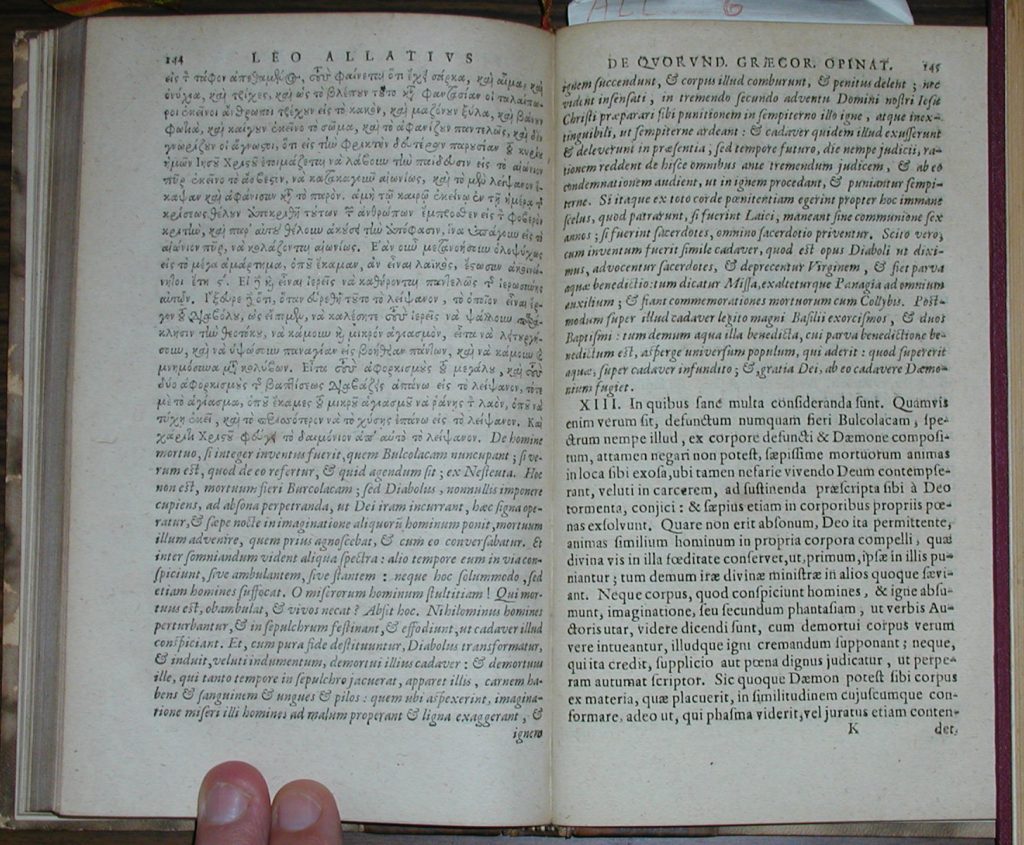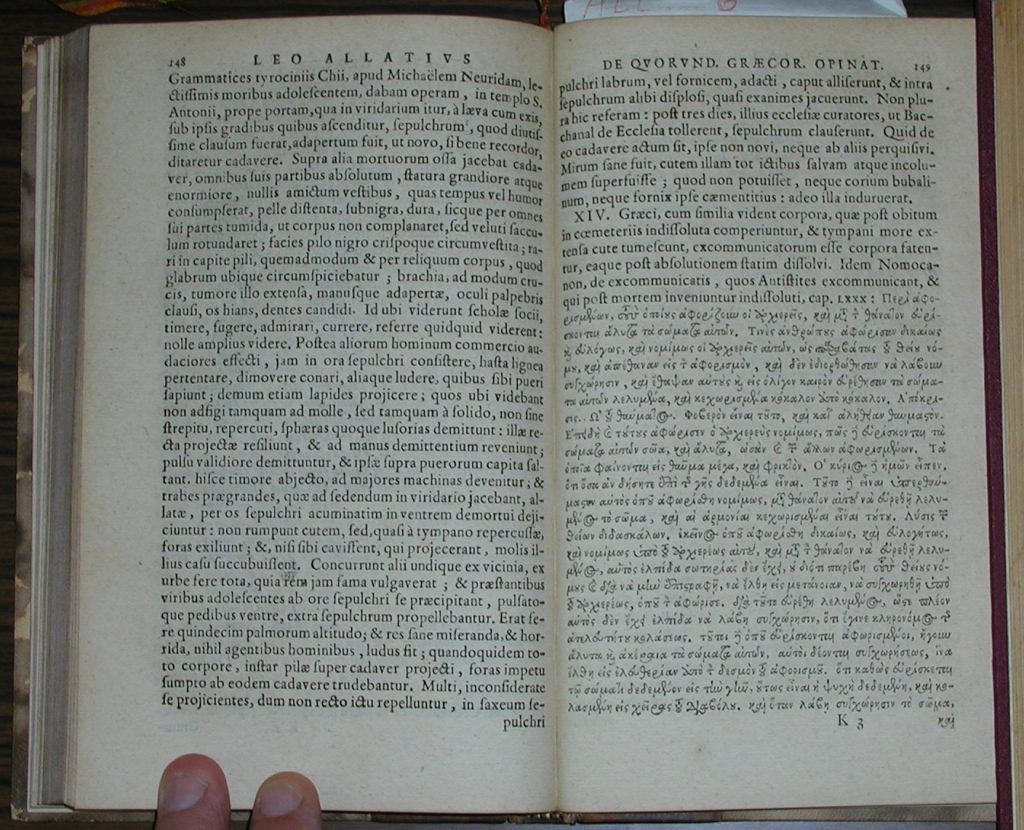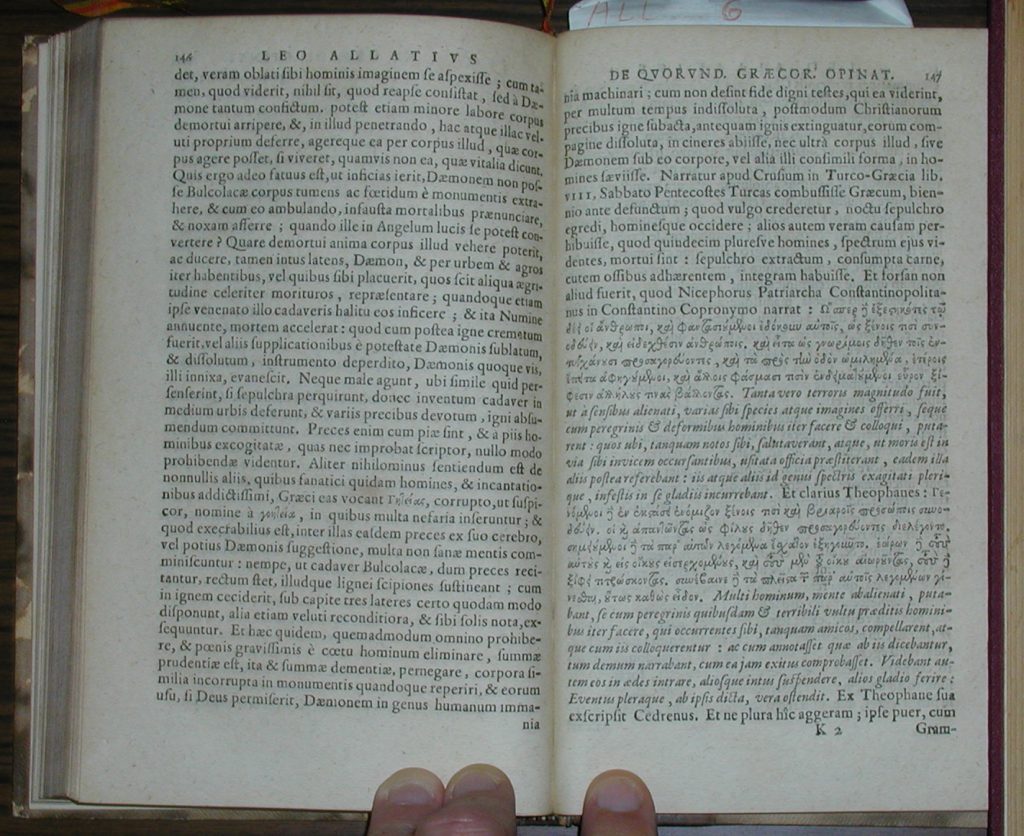|
Several considerations need to be made about the above text. For, although it is true that no dead person can ever turn into a Bulcolacas—that specter which is actually created when the Devil combines himself with a corpse—nevertheless it is impossible to deny that very often the souls of the dead, if they have scorned God by living an immoral life, are cast in places which are loathsome to them, like a prison, to suffer the punishment assigned by God. Even more often, they serve their sentence in their own bodies. Therefore, should God allow it, it would not be out of place for the souls of such men to remain imprisoned in their own bodies—preserved in that gruesome condition by God’s power—so that they can suffer punishment inside themselves, as well as bring punishment to others, acting as envoys of God’s wrath. Nor can we say that a corpse which people are able to see and burn is the product of our imagination or, in the author’s own words, a vision, since they actually see the body and place it on the flames to be incinerated. Nor, as the author wrongly claims, should anybody who holds such beliefs be judged worthy of torture and punishment. The Devil is in fact quite capable of making himself a body out of whatever matter and in whatever likeness he wishes, so that anybody who has such a vision would claim under oath to have seen the real image of a man walking up to him. Yet apparitions of that sort do not have anything real in them, but are completely made up: with much less effort the Devil can just steal a dead body, enter it, move around in it as if it were his own, and do with it what a body can do—be alive, although he cannot do the things that we call vital. Who could be then so obtuse as to deny that the Devil, who is even able to transform himself in the Angel of Light, has the power to retrieve the bloated and foul-smelling body of a Bulcolacas from a cemetery and walk around in it, announcing disasters and causing grief to mankind? Therefore a demon, hiding inside, could move the corpse of a man who was dead in spirit, and steer it, and appear to people travelling across town or in the countryside, or to anyone he pleases, whom he knows will die soon from some illness. At times he infects them himself with the corpse’s poisoned breath and, if God consents, delivers them to their death more quickly. Therefore, when a corpse like that is burnt, or is taken from the Devil’s influence through other rituals and destroyed, so disappears the Devil’s power which depended on it, once its instrument has been lost. Nor it is wrong if people, when they realize that something of the sort is happening, start searching the graveyards until they find the corpse and, taking it to the town’s central square, burn it down to ashes, after reciting different types of prayers over it. For prayers are the pious creations of pious men, which not even Nesteutes condemns, and they should not be restricted in any way. Nevertheless one must feel differently about all those other forms of prayer (Greeks call them Geteias, from what I suspect to be a corruption of the the word Goeteia), which are especially appealing to individuals addicted to magic and are full of impious content. What is even more appalling, with those same prayers they mix insane practices which spring from their own brains, or rather, from the Devil’s influence. Namely: to make the Bulcolacas’ body stand upright while the prayers are recited, they prop it with wooden bars. When it falls into the fire, they arrange three bricks under his head in a certain particular way and perform other, even more arcane rites, which are known only to them. Just as it is very wise to forbid by all means such practices and eradicate them from the community with the harshest sanctions, so it is very foolish to deny that from time to time such undecomposed corpses are found in their tombs and that, with God’s consent, the Devil uses them to devise great dangers for the human race. There is no lack of trustworthy witnesses who have seen how such a creature, uncorrupted for a long time, after it is placed in the fire among the prayers of the faithful, starts to come apart before the fire is extinguished and dissolves into ashes, and how, after that, the corpse or the Devil who hides inside it (or inside some other shape similar to it) no longer goes around attacking people. In Crusius’ Turco-Graecia, bk. 8, is the report that the Turks cremated a Greek, who had been dead for two years, on the Saturday of Pentecost. According to popular belief, he came out of his grave and killed people. But others give the true story, stating that fifteen or more people died, after seeing his ghost. When he was removed from the tomb, he had his skin intact and stretched over the bones, although the muscle tissue was gone. Perhaps what happened there was no different from what the patriarch Nicephorus reports, in the work by Constantine Copronymus,
So great was the fear that people, completely out of their wits, believed that they were seeing all sorts of shapes and apparitions coming towards them or that they were walking and conversing with weird and misshapen men. These they greeted as they would with an acquaintance, exchanging with them the usual words that wayfarers say to one another. Then they reported the occurrence to others. Driven mad by these and other similar specters, they were throwing themselves at each other with drawn swords.
Theophanes is even more explicit,
Going mad, many people started to believe that they were accompanied on the road by some mysterious and dreadful-looking wayfarers, who would approach them and start talking to them as if they were friends. But when people noted what the creatures said, they were explaining their death. They saw the same creatures entering into houses, hanging some of the occupants and cutting down others with swords. In the end, most of what they were saying proved in fact to be true.
Cedrenus draws from Theophanes for his account. But I do not want to keep piling up evidence: back in my childhood days, when I was studying in Chios under the young and very learned teacher Michael Neurides, at the church of St. Anthony, near the doorway to the courtyard, on the left hand side and under the very stairs which lead up to the yard, a grave which had been sealed for a long time was opened again to receive, if I remember well, a new body. On top of the other people’s bones lay a corpse with all its joints undone. It was abnormally large in size and had no clothes on (as time or humidity had consumed them.) Its skin was stretched out, nearly black in color, tough, and so swollen that the body did not lie flat, but was rounded all over like a pouch. Its face was thickly covered with a black and curly hair, but the head was almost bald, just as the rest of the body, which looked smooth from every side. Because of the swelling, its arms were stretched out like those of cross. The hands were open, the eyelids closed, the mouth gaping over white teeth. As soon as they saw it, my schoolmates were frightened and ran away in awe, rushing to report what they had seen. They did not want to look at it any longer. Later, emboldened by the presence of other people, they went back to the grave. Standing at its edge, they were poking at the corpse with wooden poles, trying to break it apart and playing a lot of other tricks of which only a child’s mind is capable. Eventually they started to throw rocks at it. And when they saw the rocks bounce from the body as if they were hitting not a soft, but a solid surface, and not without a noise, they began throwing play-balls at it. They bounced right back into the pitcher’s hands and, when more power was applied, leapt well above the boys’ heads. Once their fear had faded away, the children moved on to even bigger tricks. Bringing over some very large wooden beams, which were used in the yard as benches, they began to throw them spearlike at the corpse’s belly through the tomb’s opening. These could not tear the skin, but leaped back out of the grave as if bouncing on a drum. And if the tricksters had not been careful, they could have been killed under that falling mass of wood. As the rumor spread, other people were gathering from the neighborhood and all over town. The most athletic among the local youths began to jump from the grave’s edge, bouncing back out of tomb as soon as they landed with their feet on the corpse’s belly. The grave was about fifteen palms deep, and from these grisly circumstances a game developed, which nobody tried to stop. For the youngsters were being ejected from the tomb with their entire body, rebounding above the corpse like balls. Jumping recklessly, many bounced the wrong way and hit their head against the grave’s stony edge or vault; they fell back inside the grave and lay there almost unconscious. But I will say no more. After three days, in order to rid the church from those bacchanals, the supervisors of St. Anthony’s sealed the tomb again. What was done about that corpse, I never knew or asked. The amazing thing is that after all those blows its skin remained intact, something that not even a cowhide or a cement vault could do: so hard it had become.
|


